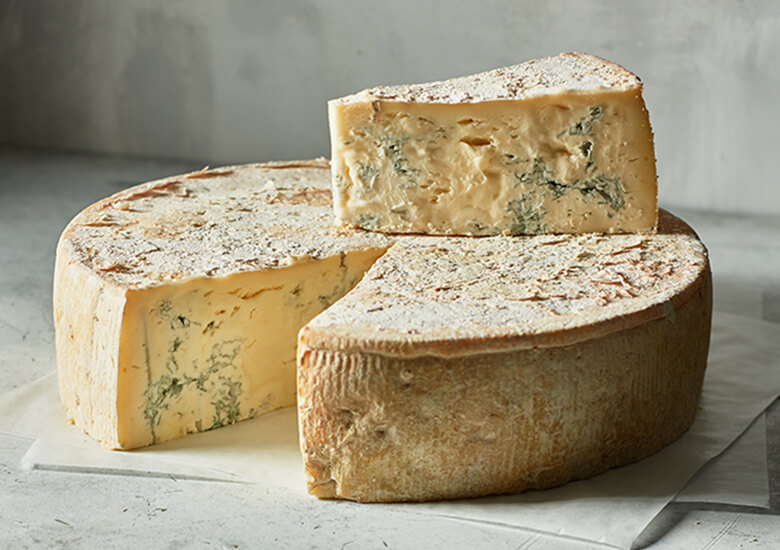Gorgonzola cheese, originating from the town of Gorgonzola, Italy, carries an exceptional allure for cheese enthusiasts worldwide due to its unique taste and production process. It stands out from the crowd of numerous other cheeses due to its trademark blue veined appearance and tangy, robust flavor that ranges from mild to sharp.
Gorgonzola has a rich history and is one of the world’s oldest blue-veined cheeses dating back to the 9th century. It is a DOP product (‘Denominazione di Origine Protetta’), meaning that it can only be officially labelled “Gorgonzola” if it adheres to specific production conditions and is yielded in the Italian regions of Piedmont or Lombardy.
The production process of Gorgonzola is meticulous and unique. The raw or pasteurized cow’s milk used undergoes a rigorous process. It involves inoculation with specific species of Penicillium to promote the growth of the characteristic blue-green veins. The cheese is then aged for a minimum of 50 days for Gorgonzola Dolce and 80 days for Gorgonzola Piccante. Gorgonzola Dolce is noted for its creamy texture and mild flavor, while Gorgonzola Piccante, aged longer, has a crumbly texture and a more pronounced, piquant taste.
Notable for its versatility, Gorgonzola can be savored in various cuisines. Some of the mouthwatering uses include:
- As a topping for pizzas and pastas, providing a savory kick.
- In salads, offering a distinct contrast to lighter flavors.
- On its own, paired with a hearty red wine or fresh fruit.
Moreover, the cheese boasts several health benefits owing to its high levels of calcium and rich probiotic content.

The bottom line is, Gorgonzola cheese is not just a treat to the palette, it also provides an intriguing window into Italian gastronomic heritage and cheese-making artistry.
Welcome to our quiz on Gorgonzola cheese! Discover how well you know this tantalizing and complex cheese. From its blue veins to the rich taste and texture, we’ll test your knowledge on all things Gorgonzola. Are you ready to delve into the world of this iconic Italian cheese? Let’s begin!
Gorgonzola: A Dive into its Origins and Production Areas
Steeped in tradition and marked with unique character, Gorgonzola is an emblem of Italian culinary heritage. This blue-veined cheese is notably produced in two Northern Italian regions namely, Piedmont and Lombardy. It was named after a small town in Lombardy where it’s believed to have been created in the 9th Century. Predominantly, Lombardy’s provinces of Novara, Varese, Como, Lecco, Cuneo, Casale Monferrato, Pavia, and Milan specialize in its production, as do certain areas within the Piedmont region. Specifically, in Piedmont, the provinces of Novara, Verbano-Cusio-Ossola and Vercelli are typically involved in Gorgonzola’s manufacturing process.
Positioned over 2000 meters above sea level, the mountainous regions of Piedmont and Lombardy provide an ideal climate for the production of the cheese. The Gorgonzola cheese-making process hinges heavily on a highly specific environment and natural elements, making these regions particularly favorable. Production involves an intricate process of turning locally-sourced milk into curd, which is then mixed with Penicillium glaucum—a defining ingredient and the source of Gorgonzola’s characteristic blue-green veins. The quality and flavor of Gorgonzola are vastly influenced by the quality of the milk and this is largely determined by the diet of the cows grazing in these regions.
- The Protected Designation of Origin (PDO) status that Gorgonzola holds ensures that only cheese produced in these particular provinces can be officially classified as Gorgonzola. The Consorzio per la Tutela del Formaggio Gorgonzola is a consortium responsible for overseeing the cheese production in these areas, ensuring adherence to traditional techniques and standards.
The raw authenticity of Gorgonzola, though replicated in different parts of the world, relies fundamentally on the location of its production. The history and traditional cheesemaking methods that these Italian regions provide contribute heavily to the cheese’s distinctiveness, offering a taste that is truly unique and inextricably tied to its place of origin.
Indulging in the Rich Flavors of Gorgonzola
Named after the town of its origin, Gorgonzola is a famous blue veined Italian cheese, deeply associated with exquisite gourmet experiences. With its robust flavor and creamy richness, there are many interesting ways to delight your taste buds with this culinary masterpiece.

The most traditional way to enjoy Gorgonzola is on its own, at room temperature, which enhances its aroma and flavors. Pairs beautifully with a glass of sweet and structured red wines such as Amarone or Barolo, it is a favorite dessert cheese among Italians. Additionally, it can be served as an antipasto with pears, grapes or drizzled with a little honey to contrast the spiciness and create a harmonious taste on your palate.
Yet, Gorgonzola is also often used in cooking extravagant dishes. The cheese melts well, and it’s commonly used in risottos and pasta, giving these dishes a wonderfully distinctive flavor. You can incorporate Gorgonzola in your dishes in the following ways:
- Melt some Gorgonzola over your steak for a lusciously rich sauce.
- Create a creamy pasta sauce using Gorgonzola, heavy cream, and a blend of fresh herbs.
- Use it as a stuffing for roasted meat or poultry to bring a beautiful depth of flavor.
Gorgonzola is extremely versatile – its applications are only limited by your culinary creativity. This Prized Italian gem offers a remarkable journey of complex flavors, from slightly sweet to pleasantly piquant, and its buttery texture adds a touch of luxury to any dish it graces. Whether you fancy it solo, paired with fruits and wine, or as a star ingredient in your favorite recipes, Gorgonzola promises an immersive gastronomic experience. Indulge intelligently and let its unique flavors transport you right to the heart of Italy.
- Fact: Gorgonzola cheese dates back to the early middle ages, making its history as rich as its flavor.
- Record: Italy produces around 4.5 million wheels of Gorgonzola every year.
- Discovery: There are two types of Gorgonzola cheese: Gorgonzola Dolce (sweet) and Gorgonzola Piccante (spicy).
- Highlight: The characteristic blue veins of Gorgonzola are made by adding cultures of the mold Penicillium glaucum to the cheese.
- Revelation: Gorgonzola was granted PDO (Protected Designation of Origin) status by the European Union in 1996.
- Observation: Despite its strong flavor, Gorgonzola cheese pairs beautifully with a variety of foods including fruits, honey, and wine.
- Highlight: A hint of Gorgonzola cheese can add a rich and flavorful twist to a wide array of dishes from risottos to salads and desserts.
Preserving the Rich Flavors of Gorgonzola Cheese
Crumbly yet creamy, Gorgonzola cheese is an Italian blue-veined cheese that is loved by many for its tangy, distinct flavor. Aged between two to four months, this cheese’s flavor profile ranges from mild to sharp depending on the variety; dolce, for lighter, creamier options and piccante for a crumblier, stronger flavor. Because of its delicate composition, proper storage is crucial in maintaining its quality and extending its shelf life.
Firstly, ensure your hands are clean or wear gloves when handling Gorgonzola to prevent the intrusion of foreign bacteria that could alter its taste. The ideal way to store Gorgonzola is to wrap it in wax or parchment paper and then loosely envelop it in aluminum foil. Plastic wrap is not recommended as it may suffocate the cheese, causing it to perspire ‘cheese sweat’, which affects the flavor.
- Refrigerator: Gorgonzola needs to be kept in a refrigerator, ideally at a temperature of between 2°C and 4°C (36°F – 39°F). Contained within a cheese box or wrapped and placed in a crisper drawer, it should last two to three weeks. Be sure to abide by the ‘first-in-first-out’ principle to avoid any wastage.
- Freezing: For a longer storage period, you can freeze Gorgonzola cheese. However, this may slightly alter its texture, making it crumblier and less creamy. Since flavors might degrade over time, it is advisable to consume thawed cheese within two to three days after defrosting.
Remember, Gorgonzola, like other blue cheeses, needs to ‘breathe’, so take it out of the fridge about 30 minutes before consumption to let it reach room temperature. This will allow its flavors and aromas to intensify, providing you with a richer cheese experience.
Exploring the Perfect Wine Pairings for Gorgonzola Cheese
One of the most distinct and robust cheeses, Gorgonzola, with its unmistakable piquant profile and creamy texture, hails from Italy. This blue-veined delicacy easily stands out with its bold, tangy flavour which commands attention to its pairings. For the uninitiated, Gorgonzola is a blue cheese whose rich and powerful taste can appear overwhelmingly sharp. However, for the food connoisseur, matching the right wine with this delightful cheese can morph every bite into an unforgettable symphony of flavours.
Palate-pleasing pairings for Gorgonzola range from sweet dessert wines to full-bodied reds. For a splendid marriage of flavours, consider Marsala, one of Italy’s most famous dessert wines. Its sweet nuance and dried fruit flavors beautifully balance the boldness of Gorgonzola, creating an indulgent harmony. Featuring more complex notes, robust red wines such as Barbaresco and Barolo integrate well with the cheese’s richness. These Piemontese wines envelop the taste buds with dark fruit flavors, firm tannins and high acidity, establishing a delectable equilibrium with the Gorgonzola.
- Sweet, luscious Port, with its deep berry and chocolate notes, forms an appetizing dichotomy with the pungent Gorgonzola. It simultaneously intensifies the cheese’s tanginess while soothing with its natural sweetness.
- A lesser-known but creative pairing is with ice wines. These special dessert wines, known for their intense sweetness and acidity, strike a beautiful balance with the ripe, zesty flavours of Gorgonzola.
Every pairing insinuates a waltz of flavours, marrying the opulent, aromatic Gorgonzola with the perfect dance partner – a fine wine. So, the next time you have Gorgonzola on the menu, you can confidently choose a wine that complements this regal cheese, enhancing the culinary affair.
Gourmet Pairings for Gorgonzola Cheese
Gorgonzola, a veined Italian blue cheese, originally from Milan, is renowned for its pungent aroma and strong flavor. It is produced from pasteurized or unpasteurized cow’s milk, which is then aged for three to six months. There are two variants of this luscious cheese — Dolce (sweet) and Piccante (sharp). The Dolce variety is creamy and mellow, while the Piccante has a crumbly texture and tangy taste. What makes this cheese an absolute delight is the art of properly pairing it with the right foods
One of the most traditional ways to enjoy Gorgonzola is in risotto or gnocchi, allowing the cheese’s creamy texture to shine. It can also be served on top of polenta, a popular Italian cornmeal dish. For those with a sweet tooth, pairing Gorgonzola with honey is a must-try. The sweetness of the honey complements the saltiness of the cheese perfectly, creating a fusion of flavors.
Choosing the right wine for Gorgonzola is significant, and what better choice can be there than sweet Italian wine? Marsala, Moscato, and Passito di Pantelleria are all excellent choices. These wines possess a sweet character that contrasts exquisitely with the potentially salty and powerful Gorgonzola. Offering a fruit and cheese plate alongside a glass of wine can elevate your cheese tasting experience. Thin slices of apples or pears combined with nuts such as almonds and walnuts enrich the entire dining experience.
- Gorgonzola and honey
- Gorgonzola and fruits
- Gorgonzola and wine
- Gorgonzola in risotto or gnocchi
Discover Alternatives to Gorgonzola: Unearthing the World of Blue Cheese
Gorgonzola, a blue-veined cheese that traces its roots back to the town of Gorgonzola in Italy, is beloved for its creamy texture and distinct tang. However, the world of cheese offers endless alternatives that can deliver an equally thrilling gustatory experience. From the peppery punch of Roquefort to the spicy bite of Stilton, the blue cheese family is rich and diverse, promising a flavorful adventure for food lovers.
Gorgonzola is often characterized by its creamy texture and a unique balance of sweet and salty notes that contribute to its powerful flavor. The cheese often carries a delightful, lingering aftertaste that only adds to its charm. Nevertheless, exploring similar cheeses can be an excellent culinary journey:
- Roquefort: Produced in the south of France, Roquefort is one of the world’s oldest known blue cheeses. Made from sheep milk, it features pungent, sharp notes and a softer, crumblier texture than Gorgonzola.
- Stilton: Hailing from England, Stilton strikes an excellent balance between creaminess and tang. This British blue cheese has a strong, rich and slightly spicy flavor that sets it apart.
Both Roquefort and Stilton bring their own unique elements to the table, and trying them opens up an entirely new palette of flavors, aromas, and textures for cheese lovers to enjoy. Diverse in their making, these cheeses can also lead to a heightened appreciation for the craft of cheese-making itself. From France’s Roquefort caves to the British heartlands of Stilton production, the adventure is as much about the flavor as it is about the history, the tradition, and the passion that goes into every wheel.
The Tale of Gorgonzola Cheese: A Rich and Milky Legacy
Steeped in a centuries-old tradition of Lombardy, Italy, Gorgonzola is a blue-veined cheese with a deep history and a delectable taste. Its origins run back to around 879 AD, its name pinned on the township of Gorgonzola located near Milan. Ancient tales have it that the cheese was a result of a young cheese maker, who after a day’s work retired early leaving a curd meant for a different kind of cheese altogether. The following day, with a fresh curd, he tried to marry the two and a few months later, there were streaks of blue mold born of the night air running through his creation, which came to be the first Gorgonzola cheese.
Originally, Gorgonzola was aged in naturally cool, humidity-controlled caves of the town which helped develop its characteristic blue veins. Today, quintessential Gorgonzola still follows a similar maturing process which takes between two and four months. The cheese is often categorized into two types – Dolce (sweet), being soft and creamy and enjoyed younger; and Piccante (spicy or sharp), which is firmer, crumbly and carries a robust flavor when mature. Authentic Gorgonzola cheese is stamped with a mark of guarantee – DOP (Denominazione di Origine Protetta), a certification that means the cheese is made according to traditional methods within a specific region.
Not only does the unique taste of Gorgonzola lend itself well to different cuisines, but this cheese is also rich in vital nutrients necessary for good health. Gorgonzola is high in protein, calcium, and vitamin B12 while being a key player in a balanced diet.
- Gorgonzola, with a minimum of 48% fat, contains about 12g protein per 100g serving.
- It provides about 395mg calcium per 100g, covering nearly 40% of the daily required intake.
- This cheese serves up about 1.3 mcg of vitamin B12 per 100g, catering to 50% of daily vitamin B12 needs.


